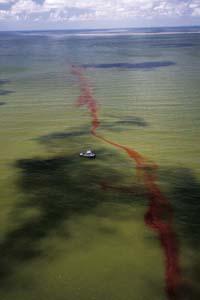Chemical Ravine of the Gulf of Mexico Spill

Despite questioning the suitability of conventional dispersants, they have not found any better products.
The oil spill caused by the Deepwater Horizon platform, which exploded and sank in the Gulf of Mexico on April 21, has caused more than one headache. As with any oil spill at sea, they have had to organize actions to protect the environment. In this sense, concerns have been raised about the chemistry of dispersing substances. In fact, the U.S. environmental agency EPA questioned the suitability of conventional dispersants, but after rapid research it did not find a better substitute product.
The very way to treat the spill generates a paradox. The oil spots in the sea are large and evaporate or degrade very slowly, so they are dangerous for living things for a long time. The function of the dispersants is to break the spots into smaller parts. But traditional dispersants are toxic, which causes a paradox.
The main disperser used by the owner of the British Petroleum (BP) platform, Corexit 9500, is not new, but was used in the dumping of the oil tanker Exxon Valdez, because the Corexit 9527, which until then used, is much more toxic. However, on 20 May, the EPA requested the BP to use a new disperser for the toxicity of Corexit 9500. BP responded that they had no safer substitutes and the EPA itself began to seek a substitute. However, after analyzing the toxicity of eight dispersants, he does not find it.
The experts are concerned. All conventional dispersants are less toxic than oil, but the combination of both substances is very high. In addition, the addition of dispersants has the disadvantage that it helps oil to sink, so oil affects more organisms than at first. Therefore, the decision that the EPA had to make was not easy, the results of the investigation were published on July 8 and the BP continued to use Corexit 9500.
Buletina
Bidali zure helbide elektronikoa eta jaso asteroko buletina zure sarrera-ontzian











